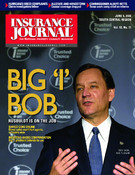In a move it says will “help protect its ability to meet future customer needs throughout Texas while maintaining a strong presence along the Texas coast,” Allstate Texas Lloyds announced it is phasing out windstorm coverage for homeowners along the state’s coastline.
With approximately 750,000 policyholders in Texas, the company holds nearly 16 percent of the homeowners market; it is the state’s second largest homeowners insurer after State Farm. About 65,000 customers will be affected by the current action, according to Joe McCormick, senior corporate relations manager for Allstate’s Texas region.
Earlier this year Allstate stopped writing new homeowners polices in some coastal areas, but Mc-Cormick said that change does not affect current customers. “In fact, we are writing new business for current customers in most cases when they move to a different house in a coastal area. This is an important point,” he said.
Beginning Sept. 15, the company will move the windstorm coverage for current customers in Coastal Zone 1 to the Texas Windstorm Insurance Association, the insurer of last resort for windstorm coverage.
Coastal Zone 1 includes the following counties: Jefferson, Chambers, Galveston, Brazoria, Matagorda, Calhoun, Refugio, Aransas, San Patricio, Nueces, Kleberg, Kenedy, Willacy and Cameron.
Also starting this fall, for homes located in the second and third tier of counties inland from the coast (Costal Zones 2 and 3), the company will require a 2 percent tropical cyclone deductible (TCD) for those policies not already at that level.
Coastal Zone 2 counties are: Orange, Hardin, Liberty, Harris, Fort Bend, Wharton, Jackson, Victoria, Goliad, Bee, Live Oak, Jim Wells, Brooks and Hidalgo.
Zone 3 counties are: Newton, Jasper, Tyler, Polk, San Jacinto, Walker, Montgomery, Waller, Austin, Colorado, Lavaca, DeWitt, Gonzales, Karnes, McMullen, Duval, Jim Hogg and Starr.
TWIA underfunded
According to Jerry Johns, a spokesman for TWIA, the association “is fully prepared to accept additional customers from Allstate. TWIA is quickly becoming one of the largest writers of wind coverage in the state with 12,000 residential and commercial policyholders and growing at about 1,000 policies each week.”
Johns added, however, that the “issue of funding TWIA in the event of a major hurricane is still a looming concern. We had hoped our request to issue $800 million in bonds would be placed on the call for last legislative session, but, unfortunately that did not take place.”
On May 26 Texas Insurance Commissioner Mike Geeslin signed an order increasing TWIA’s rates for homeowners wind coverage by 3.1 percent and commercial rates by 8 percent. TWIA previously had asked for an increase in homeowners rates of 19 percent and commercial rates of 24 percent.
Geeslin also signed an order allowing TWIA to surcharge windpool applicants seeking wind coverage through an approval process that does not require the standard windstorm inspection. The allowed surcharge is 5 percent; TWIA had asked for a 25 percent surcharge.
Johns acknowledged that the rate increase will help, but he reiterated the importance of a long-term funding mechanism for the insurer. “Contrary to what many people believe, the matter of financial vitality for TWIA is a state-wide issue and not one exclusive to the coastal regions of Texas,” Johns said. “If TWIA were to exhaust their funds paying claims following a major hurricane then the Texas General Revenue fund would be impacted and that is not a good thing.”
The Insurance Council of Texas said the approved rate increase “keeps rates inadequately low … and only aggravates the association’s existing problems.”
“You don’t have to look far to see what happens when you charge artificially low rates and the inevitable bad storm comes along,” said ICT spokesman Mark Hanna, in an announcement. “Look at the dramatically higher rates coastal homeowners in Florida, Louisiana and Mississippi are now paying. If you have adequate rates in place to begin with, you don’t get clobbered with huge rate increases after a hurricane strikes.
“One clear example is Mississippi’s windpool request this week for a 397.8 percent rate increase on windstorm coverage for homeowners,” Hanna said. “It all catches up to you eventually, and when it does, the entire state suffers financially.”
Working on the details
In a statement, Allstate added it is “working out some details on the timeframe, but our goal is to implement these TCD changes as policies come up for renewal.”
The company noted it has purchased additional reinsurance to cover potential catastrophe claims, which likely “will result in higher premiums for the homes most at risk for catastrophic loss, those in coastal areas. However, customers in most parts of the state will see only a minimal impact.”
Topics Catastrophe Natural Disasters Texas Windstorm Homeowners
Was this article valuable?
Here are more articles you may enjoy.


 CRC Group Signs Agreement to Acquire Euclid Transactional
CRC Group Signs Agreement to Acquire Euclid Transactional  High-Net-Worth Risk Appetite Drops as Some Regions Show Stabilization
High-Net-Worth Risk Appetite Drops as Some Regions Show Stabilization  Berkshire Hathaway Raises New CEO Abel’s Salary to $25 Million
Berkshire Hathaway Raises New CEO Abel’s Salary to $25 Million  Good Times for US P/C Insurers May Not Last; Auto Challenges Ahead
Good Times for US P/C Insurers May Not Last; Auto Challenges Ahead 


